Capital Budgeting Analysis for Two Investment Projects
VerifiedAdded on 2020/05/28
|16
|2677
|365
AI Summary
The task is to evaluate two hypothetical investment projects, Project A and Project B, through various financial analysis techniques. It includes calculating and interpreting key metrics like Net Present Value (NPV), Internal Rate of Return (IRR), Profitability Index, Discounted Payback Period, and Payback Period. The results indicate that while Project A has a higher NPV, Project B is preferable due to its favorable outcomes in most other investment decision criteria including IRR, profitability index, and discounted payback period. The assignment concludes that Project B should be accepted as it demonstrates better financial performance across the evaluated metrics.
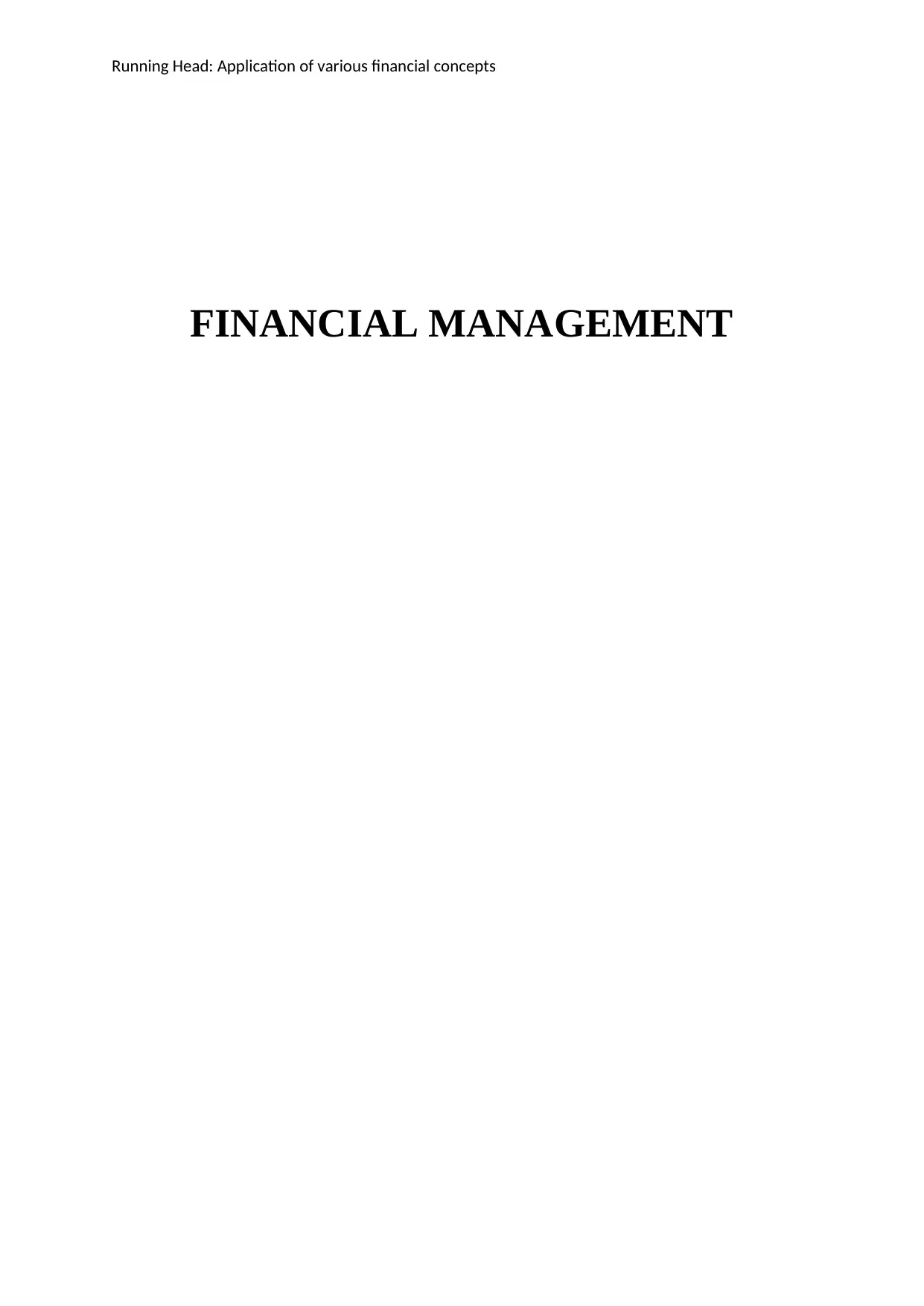
Running Head: Application of various financial concepts
FINANCIAL MANAGEMENT
FINANCIAL MANAGEMENT
Paraphrase This Document
Need a fresh take? Get an instant paraphrase of this document with our AI Paraphraser
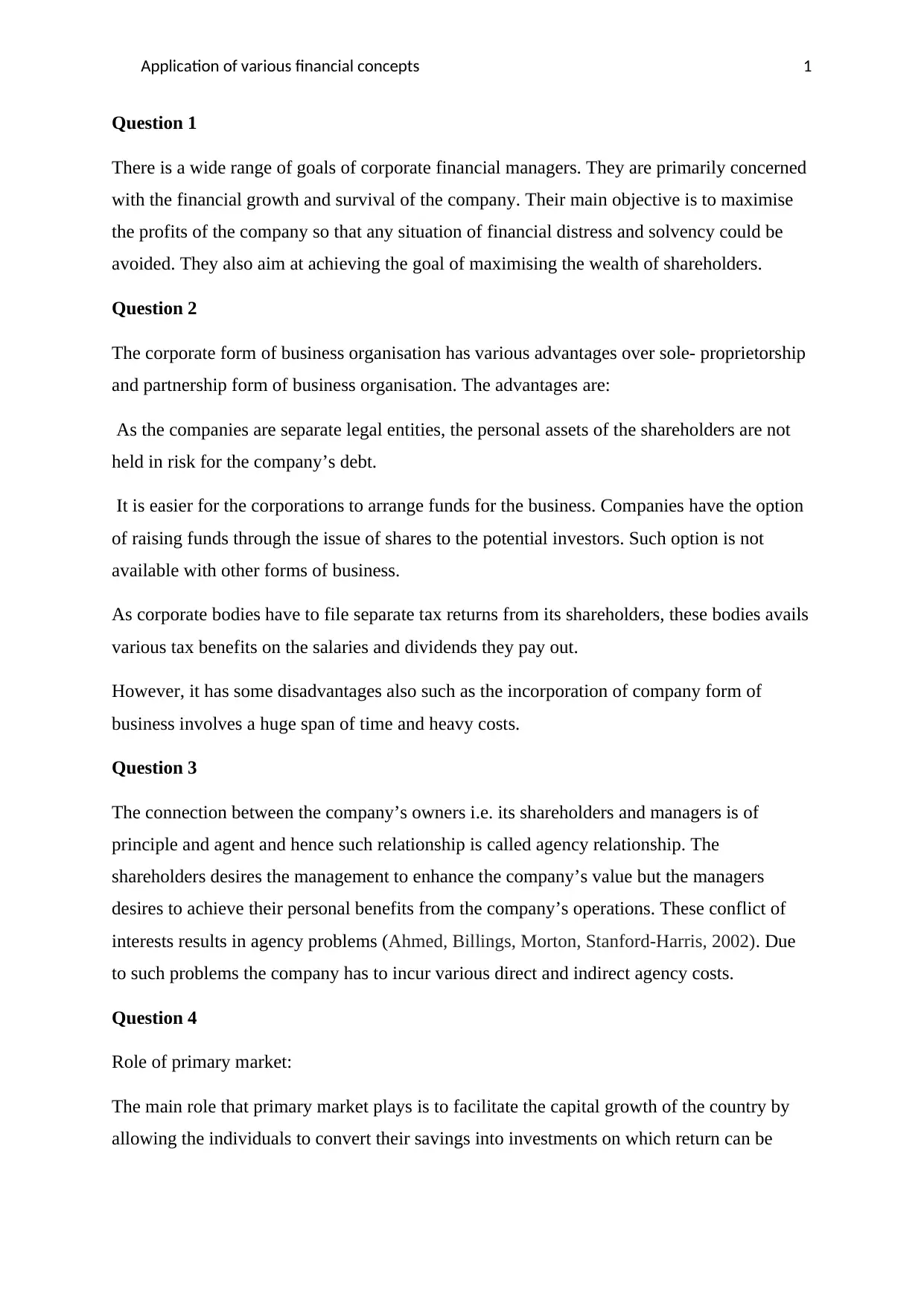
Application of various financial concepts 1
Question 1
There is a wide range of goals of corporate financial managers. They are primarily concerned
with the financial growth and survival of the company. Their main objective is to maximise
the profits of the company so that any situation of financial distress and solvency could be
avoided. They also aim at achieving the goal of maximising the wealth of shareholders.
Question 2
The corporate form of business organisation has various advantages over sole- proprietorship
and partnership form of business organisation. The advantages are:
As the companies are separate legal entities, the personal assets of the shareholders are not
held in risk for the company’s debt.
It is easier for the corporations to arrange funds for the business. Companies have the option
of raising funds through the issue of shares to the potential investors. Such option is not
available with other forms of business.
As corporate bodies have to file separate tax returns from its shareholders, these bodies avails
various tax benefits on the salaries and dividends they pay out.
However, it has some disadvantages also such as the incorporation of company form of
business involves a huge span of time and heavy costs.
Question 3
The connection between the company’s owners i.e. its shareholders and managers is of
principle and agent and hence such relationship is called agency relationship. The
shareholders desires the management to enhance the company’s value but the managers
desires to achieve their personal benefits from the company’s operations. These conflict of
interests results in agency problems (Ahmed, Billings, Morton, Stanford-Harris, 2002). Due
to such problems the company has to incur various direct and indirect agency costs.
Question 4
Role of primary market:
The main role that primary market plays is to facilitate the capital growth of the country by
allowing the individuals to convert their savings into investments on which return can be
Question 1
There is a wide range of goals of corporate financial managers. They are primarily concerned
with the financial growth and survival of the company. Their main objective is to maximise
the profits of the company so that any situation of financial distress and solvency could be
avoided. They also aim at achieving the goal of maximising the wealth of shareholders.
Question 2
The corporate form of business organisation has various advantages over sole- proprietorship
and partnership form of business organisation. The advantages are:
As the companies are separate legal entities, the personal assets of the shareholders are not
held in risk for the company’s debt.
It is easier for the corporations to arrange funds for the business. Companies have the option
of raising funds through the issue of shares to the potential investors. Such option is not
available with other forms of business.
As corporate bodies have to file separate tax returns from its shareholders, these bodies avails
various tax benefits on the salaries and dividends they pay out.
However, it has some disadvantages also such as the incorporation of company form of
business involves a huge span of time and heavy costs.
Question 3
The connection between the company’s owners i.e. its shareholders and managers is of
principle and agent and hence such relationship is called agency relationship. The
shareholders desires the management to enhance the company’s value but the managers
desires to achieve their personal benefits from the company’s operations. These conflict of
interests results in agency problems (Ahmed, Billings, Morton, Stanford-Harris, 2002). Due
to such problems the company has to incur various direct and indirect agency costs.
Question 4
Role of primary market:
The main role that primary market plays is to facilitate the capital growth of the country by
allowing the individuals to convert their savings into investments on which return can be
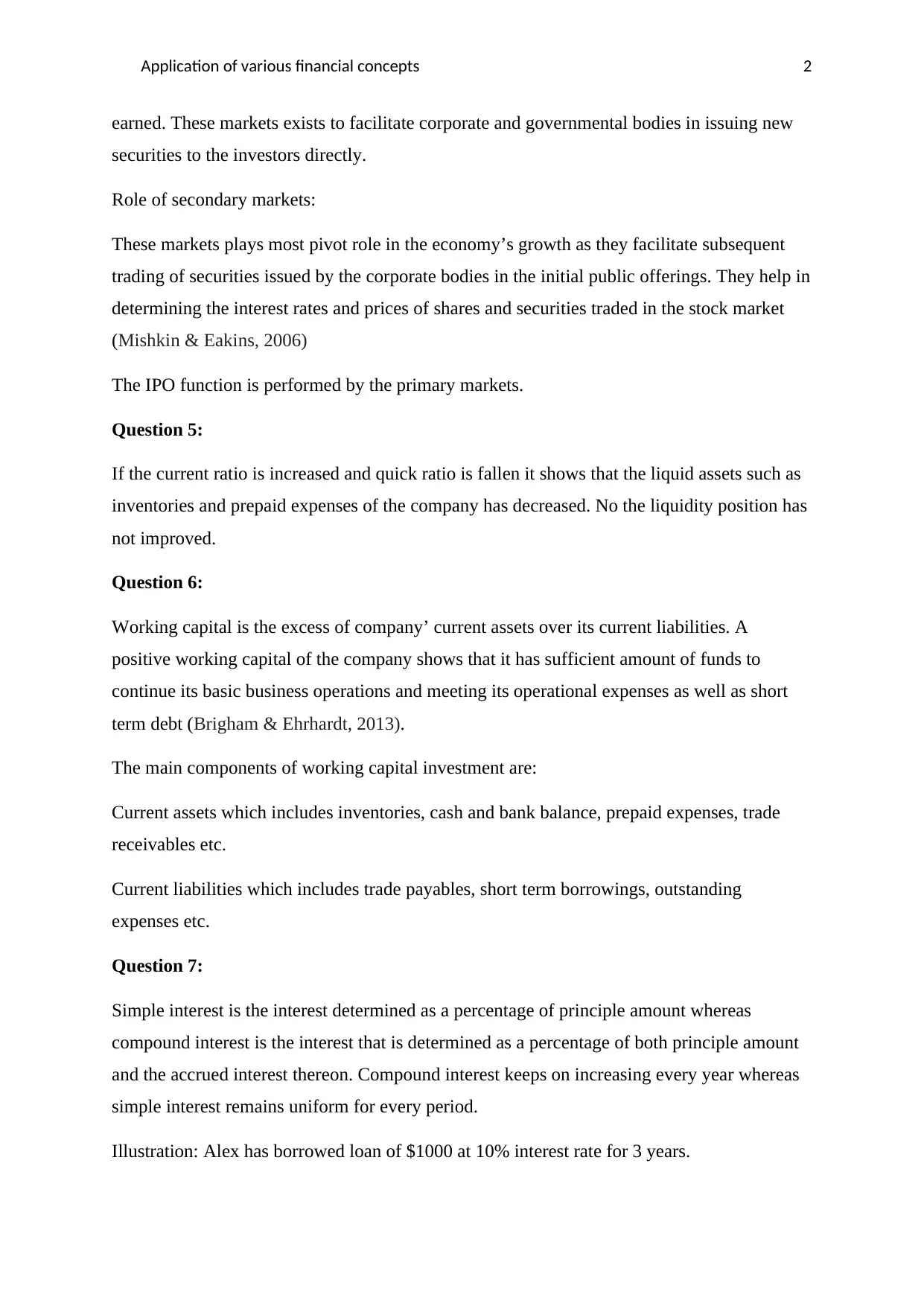
Application of various financial concepts 2
earned. These markets exists to facilitate corporate and governmental bodies in issuing new
securities to the investors directly.
Role of secondary markets:
These markets plays most pivot role in the economy’s growth as they facilitate subsequent
trading of securities issued by the corporate bodies in the initial public offerings. They help in
determining the interest rates and prices of shares and securities traded in the stock market
(Mishkin & Eakins, 2006)
The IPO function is performed by the primary markets.
Question 5:
If the current ratio is increased and quick ratio is fallen it shows that the liquid assets such as
inventories and prepaid expenses of the company has decreased. No the liquidity position has
not improved.
Question 6:
Working capital is the excess of company’ current assets over its current liabilities. A
positive working capital of the company shows that it has sufficient amount of funds to
continue its basic business operations and meeting its operational expenses as well as short
term debt (Brigham & Ehrhardt, 2013).
The main components of working capital investment are:
Current assets which includes inventories, cash and bank balance, prepaid expenses, trade
receivables etc.
Current liabilities which includes trade payables, short term borrowings, outstanding
expenses etc.
Question 7:
Simple interest is the interest determined as a percentage of principle amount whereas
compound interest is the interest that is determined as a percentage of both principle amount
and the accrued interest thereon. Compound interest keeps on increasing every year whereas
simple interest remains uniform for every period.
Illustration: Alex has borrowed loan of $1000 at 10% interest rate for 3 years.
earned. These markets exists to facilitate corporate and governmental bodies in issuing new
securities to the investors directly.
Role of secondary markets:
These markets plays most pivot role in the economy’s growth as they facilitate subsequent
trading of securities issued by the corporate bodies in the initial public offerings. They help in
determining the interest rates and prices of shares and securities traded in the stock market
(Mishkin & Eakins, 2006)
The IPO function is performed by the primary markets.
Question 5:
If the current ratio is increased and quick ratio is fallen it shows that the liquid assets such as
inventories and prepaid expenses of the company has decreased. No the liquidity position has
not improved.
Question 6:
Working capital is the excess of company’ current assets over its current liabilities. A
positive working capital of the company shows that it has sufficient amount of funds to
continue its basic business operations and meeting its operational expenses as well as short
term debt (Brigham & Ehrhardt, 2013).
The main components of working capital investment are:
Current assets which includes inventories, cash and bank balance, prepaid expenses, trade
receivables etc.
Current liabilities which includes trade payables, short term borrowings, outstanding
expenses etc.
Question 7:
Simple interest is the interest determined as a percentage of principle amount whereas
compound interest is the interest that is determined as a percentage of both principle amount
and the accrued interest thereon. Compound interest keeps on increasing every year whereas
simple interest remains uniform for every period.
Illustration: Alex has borrowed loan of $1000 at 10% interest rate for 3 years.
⊘ This is a preview!⊘
Do you want full access?
Subscribe today to unlock all pages.

Trusted by 1+ million students worldwide
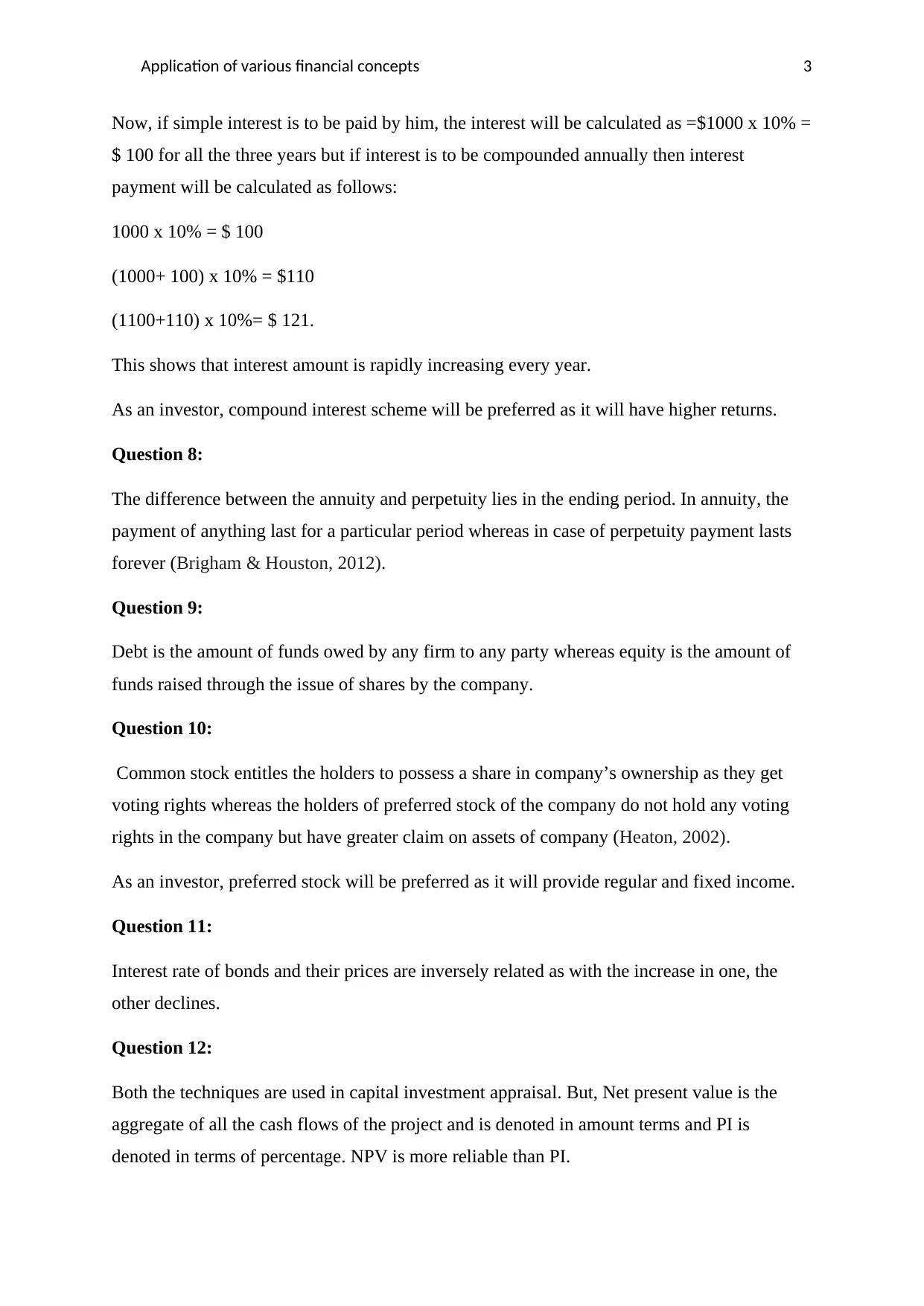
Application of various financial concepts 3
Now, if simple interest is to be paid by him, the interest will be calculated as =$1000 x 10% =
$ 100 for all the three years but if interest is to be compounded annually then interest
payment will be calculated as follows:
1000 x 10% = $ 100
(1000+ 100) x 10% = $110
(1100+110) x 10%= $ 121.
This shows that interest amount is rapidly increasing every year.
As an investor, compound interest scheme will be preferred as it will have higher returns.
Question 8:
The difference between the annuity and perpetuity lies in the ending period. In annuity, the
payment of anything last for a particular period whereas in case of perpetuity payment lasts
forever (Brigham & Houston, 2012).
Question 9:
Debt is the amount of funds owed by any firm to any party whereas equity is the amount of
funds raised through the issue of shares by the company.
Question 10:
Common stock entitles the holders to possess a share in company’s ownership as they get
voting rights whereas the holders of preferred stock of the company do not hold any voting
rights in the company but have greater claim on assets of company (Heaton, 2002).
As an investor, preferred stock will be preferred as it will provide regular and fixed income.
Question 11:
Interest rate of bonds and their prices are inversely related as with the increase in one, the
other declines.
Question 12:
Both the techniques are used in capital investment appraisal. But, Net present value is the
aggregate of all the cash flows of the project and is denoted in amount terms and PI is
denoted in terms of percentage. NPV is more reliable than PI.
Now, if simple interest is to be paid by him, the interest will be calculated as =$1000 x 10% =
$ 100 for all the three years but if interest is to be compounded annually then interest
payment will be calculated as follows:
1000 x 10% = $ 100
(1000+ 100) x 10% = $110
(1100+110) x 10%= $ 121.
This shows that interest amount is rapidly increasing every year.
As an investor, compound interest scheme will be preferred as it will have higher returns.
Question 8:
The difference between the annuity and perpetuity lies in the ending period. In annuity, the
payment of anything last for a particular period whereas in case of perpetuity payment lasts
forever (Brigham & Houston, 2012).
Question 9:
Debt is the amount of funds owed by any firm to any party whereas equity is the amount of
funds raised through the issue of shares by the company.
Question 10:
Common stock entitles the holders to possess a share in company’s ownership as they get
voting rights whereas the holders of preferred stock of the company do not hold any voting
rights in the company but have greater claim on assets of company (Heaton, 2002).
As an investor, preferred stock will be preferred as it will provide regular and fixed income.
Question 11:
Interest rate of bonds and their prices are inversely related as with the increase in one, the
other declines.
Question 12:
Both the techniques are used in capital investment appraisal. But, Net present value is the
aggregate of all the cash flows of the project and is denoted in amount terms and PI is
denoted in terms of percentage. NPV is more reliable than PI.
Paraphrase This Document
Need a fresh take? Get an instant paraphrase of this document with our AI Paraphraser
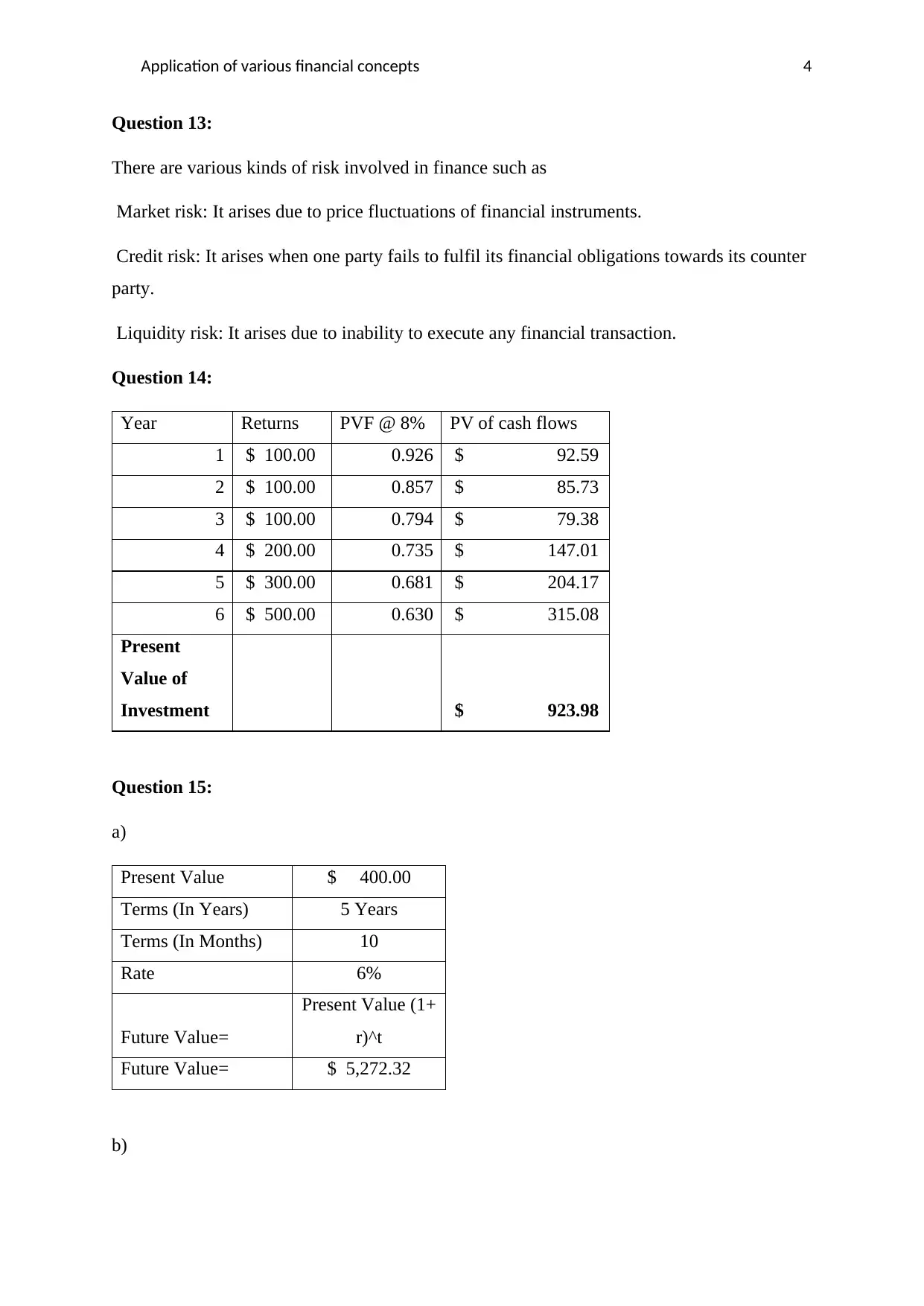
Application of various financial concepts 4
Question 13:
There are various kinds of risk involved in finance such as
Market risk: It arises due to price fluctuations of financial instruments.
Credit risk: It arises when one party fails to fulfil its financial obligations towards its counter
party.
Liquidity risk: It arises due to inability to execute any financial transaction.
Question 14:
Year Returns PVF @ 8% PV of cash flows
1 $ 100.00 0.926 $ 92.59
2 $ 100.00 0.857 $ 85.73
3 $ 100.00 0.794 $ 79.38
4 $ 200.00 0.735 $ 147.01
5 $ 300.00 0.681 $ 204.17
6 $ 500.00 0.630 $ 315.08
Present
Value of
Investment $ 923.98
Question 15:
a)
Present Value $ 400.00
Terms (In Years) 5 Years
Terms (In Months) 10
Rate 6%
Future Value=
Present Value (1+
r)^t
Future Value= $ 5,272.32
b)
Question 13:
There are various kinds of risk involved in finance such as
Market risk: It arises due to price fluctuations of financial instruments.
Credit risk: It arises when one party fails to fulfil its financial obligations towards its counter
party.
Liquidity risk: It arises due to inability to execute any financial transaction.
Question 14:
Year Returns PVF @ 8% PV of cash flows
1 $ 100.00 0.926 $ 92.59
2 $ 100.00 0.857 $ 85.73
3 $ 100.00 0.794 $ 79.38
4 $ 200.00 0.735 $ 147.01
5 $ 300.00 0.681 $ 204.17
6 $ 500.00 0.630 $ 315.08
Present
Value of
Investment $ 923.98
Question 15:
a)
Present Value $ 400.00
Terms (In Years) 5 Years
Terms (In Months) 10
Rate 6%
Future Value=
Present Value (1+
r)^t
Future Value= $ 5,272.32
b)
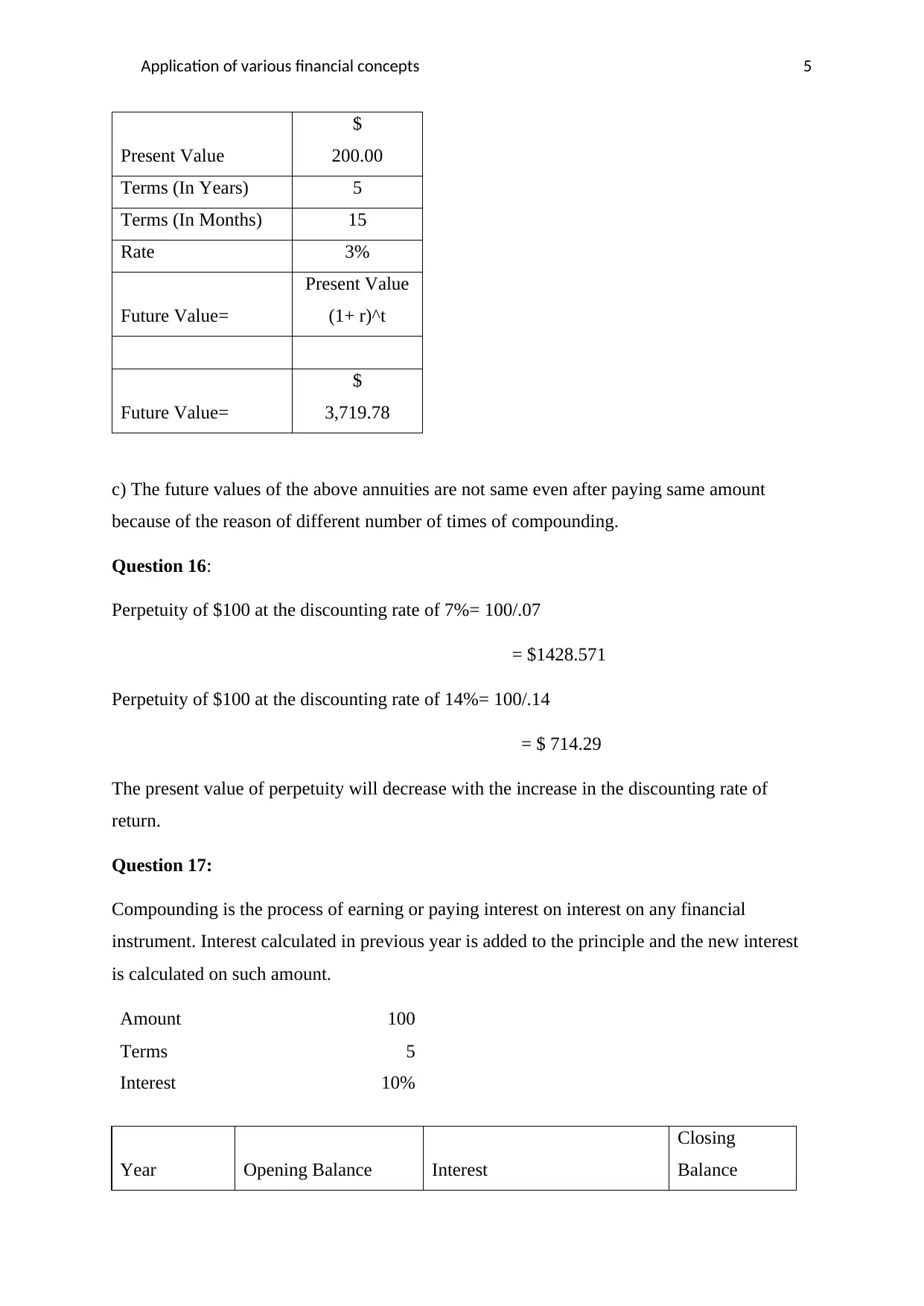
Application of various financial concepts 5
Present Value
$
200.00
Terms (In Years) 5
Terms (In Months) 15
Rate 3%
Future Value=
Present Value
(1+ r)^t
Future Value=
$
3,719.78
c) The future values of the above annuities are not same even after paying same amount
because of the reason of different number of times of compounding.
Question 16:
Perpetuity of $100 at the discounting rate of 7%= 100/.07
= $1428.571
Perpetuity of $100 at the discounting rate of 14%= 100/.14
= $ 714.29
The present value of perpetuity will decrease with the increase in the discounting rate of
return.
Question 17:
Compounding is the process of earning or paying interest on interest on any financial
instrument. Interest calculated in previous year is added to the principle and the new interest
is calculated on such amount.
Amount 100
Terms 5
Interest 10%
Year Opening Balance Interest
Closing
Balance
Present Value
$
200.00
Terms (In Years) 5
Terms (In Months) 15
Rate 3%
Future Value=
Present Value
(1+ r)^t
Future Value=
$
3,719.78
c) The future values of the above annuities are not same even after paying same amount
because of the reason of different number of times of compounding.
Question 16:
Perpetuity of $100 at the discounting rate of 7%= 100/.07
= $1428.571
Perpetuity of $100 at the discounting rate of 14%= 100/.14
= $ 714.29
The present value of perpetuity will decrease with the increase in the discounting rate of
return.
Question 17:
Compounding is the process of earning or paying interest on interest on any financial
instrument. Interest calculated in previous year is added to the principle and the new interest
is calculated on such amount.
Amount 100
Terms 5
Interest 10%
Year Opening Balance Interest
Closing
Balance
⊘ This is a preview!⊘
Do you want full access?
Subscribe today to unlock all pages.

Trusted by 1+ million students worldwide
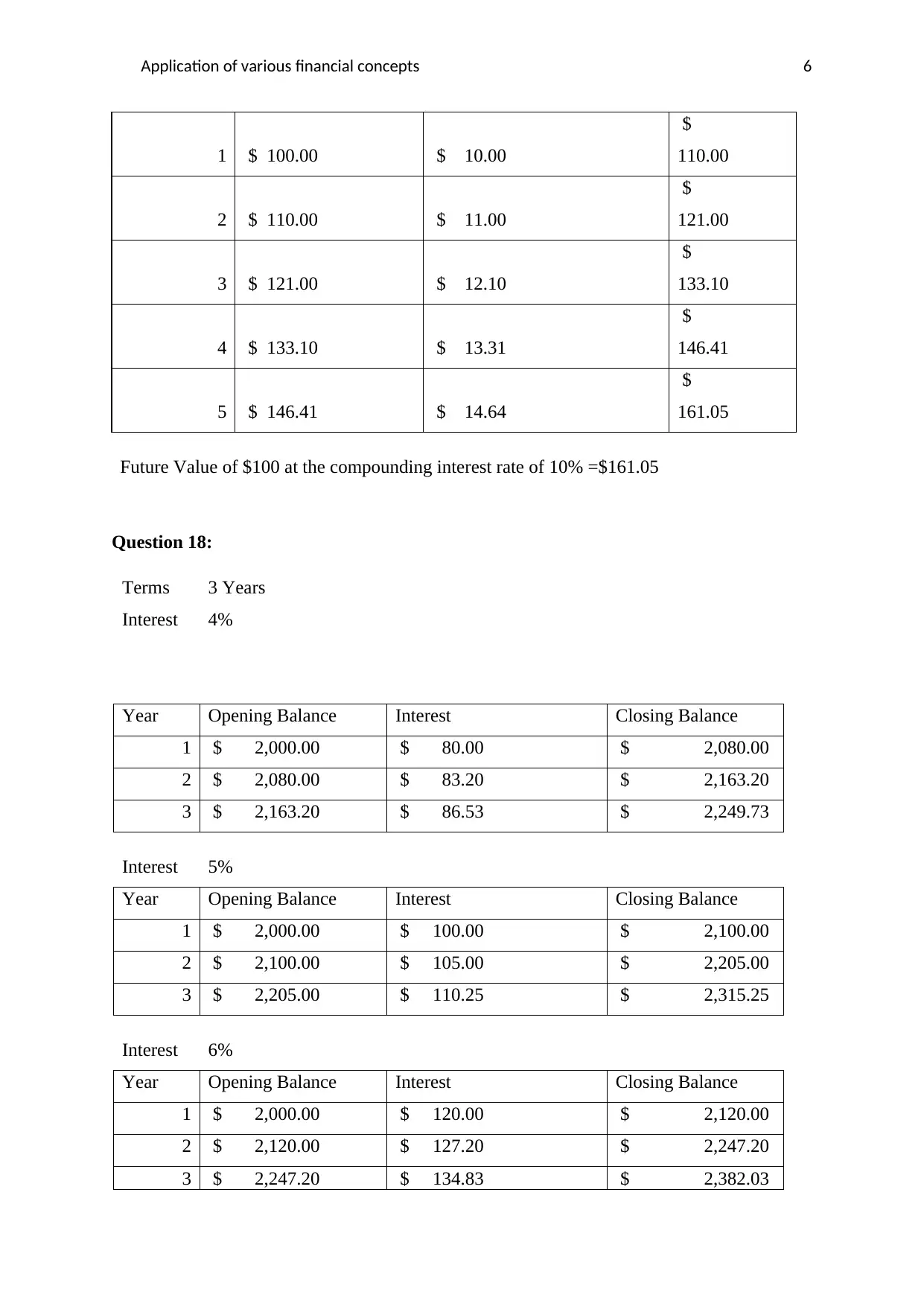
Application of various financial concepts 6
1 $ 100.00 $ 10.00
$
110.00
2 $ 110.00 $ 11.00
$
121.00
3 $ 121.00 $ 12.10
$
133.10
4 $ 133.10 $ 13.31
$
146.41
5 $ 146.41 $ 14.64
$
161.05
Future Value of $100 at the compounding interest rate of 10% =$161.05
Question 18:
Terms 3 Years
Interest 4%
Year Opening Balance Interest Closing Balance
1 $ 2,000.00 $ 80.00 $ 2,080.00
2 $ 2,080.00 $ 83.20 $ 2,163.20
3 $ 2,163.20 $ 86.53 $ 2,249.73
Interest 5%
Year Opening Balance Interest Closing Balance
1 $ 2,000.00 $ 100.00 $ 2,100.00
2 $ 2,100.00 $ 105.00 $ 2,205.00
3 $ 2,205.00 $ 110.25 $ 2,315.25
Interest 6%
Year Opening Balance Interest Closing Balance
1 $ 2,000.00 $ 120.00 $ 2,120.00
2 $ 2,120.00 $ 127.20 $ 2,247.20
3 $ 2,247.20 $ 134.83 $ 2,382.03
1 $ 100.00 $ 10.00
$
110.00
2 $ 110.00 $ 11.00
$
121.00
3 $ 121.00 $ 12.10
$
133.10
4 $ 133.10 $ 13.31
$
146.41
5 $ 146.41 $ 14.64
$
161.05
Future Value of $100 at the compounding interest rate of 10% =$161.05
Question 18:
Terms 3 Years
Interest 4%
Year Opening Balance Interest Closing Balance
1 $ 2,000.00 $ 80.00 $ 2,080.00
2 $ 2,080.00 $ 83.20 $ 2,163.20
3 $ 2,163.20 $ 86.53 $ 2,249.73
Interest 5%
Year Opening Balance Interest Closing Balance
1 $ 2,000.00 $ 100.00 $ 2,100.00
2 $ 2,100.00 $ 105.00 $ 2,205.00
3 $ 2,205.00 $ 110.25 $ 2,315.25
Interest 6%
Year Opening Balance Interest Closing Balance
1 $ 2,000.00 $ 120.00 $ 2,120.00
2 $ 2,120.00 $ 127.20 $ 2,247.20
3 $ 2,247.20 $ 134.83 $ 2,382.03
Paraphrase This Document
Need a fresh take? Get an instant paraphrase of this document with our AI Paraphraser
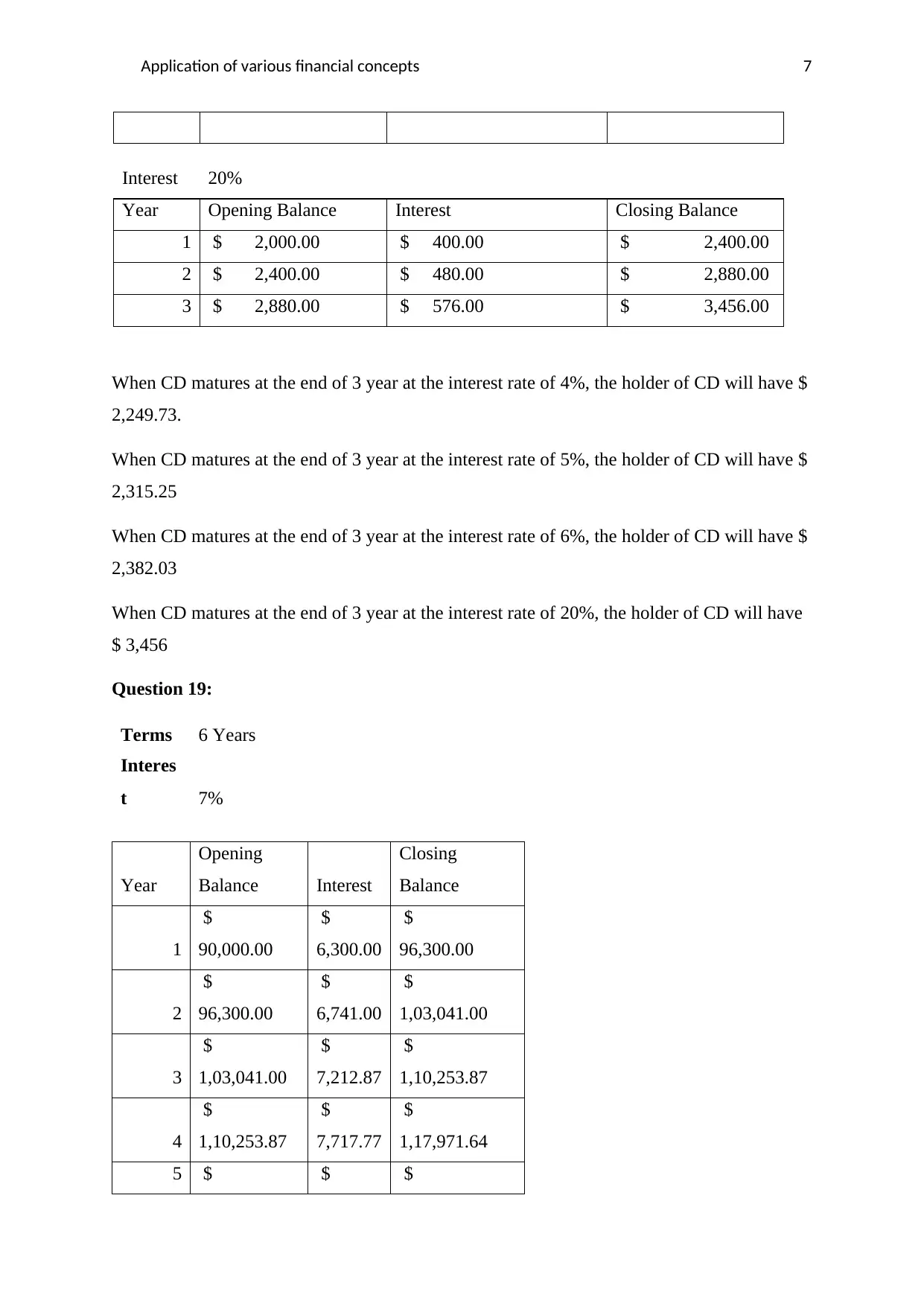
Application of various financial concepts 7
Interest 20%
Year Opening Balance Interest Closing Balance
1 $ 2,000.00 $ 400.00 $ 2,400.00
2 $ 2,400.00 $ 480.00 $ 2,880.00
3 $ 2,880.00 $ 576.00 $ 3,456.00
When CD matures at the end of 3 year at the interest rate of 4%, the holder of CD will have $
2,249.73.
When CD matures at the end of 3 year at the interest rate of 5%, the holder of CD will have $
2,315.25
When CD matures at the end of 3 year at the interest rate of 6%, the holder of CD will have $
2,382.03
When CD matures at the end of 3 year at the interest rate of 20%, the holder of CD will have
$ 3,456
Question 19:
Terms 6 Years
Interes
t 7%
Year
Opening
Balance Interest
Closing
Balance
1
$
90,000.00
$
6,300.00
$
96,300.00
2
$
96,300.00
$
6,741.00
$
1,03,041.00
3
$
1,03,041.00
$
7,212.87
$
1,10,253.87
4
$
1,10,253.87
$
7,717.77
$
1,17,971.64
5 $ $ $
Interest 20%
Year Opening Balance Interest Closing Balance
1 $ 2,000.00 $ 400.00 $ 2,400.00
2 $ 2,400.00 $ 480.00 $ 2,880.00
3 $ 2,880.00 $ 576.00 $ 3,456.00
When CD matures at the end of 3 year at the interest rate of 4%, the holder of CD will have $
2,249.73.
When CD matures at the end of 3 year at the interest rate of 5%, the holder of CD will have $
2,315.25
When CD matures at the end of 3 year at the interest rate of 6%, the holder of CD will have $
2,382.03
When CD matures at the end of 3 year at the interest rate of 20%, the holder of CD will have
$ 3,456
Question 19:
Terms 6 Years
Interes
t 7%
Year
Opening
Balance Interest
Closing
Balance
1
$
90,000.00
$
6,300.00
$
96,300.00
2
$
96,300.00
$
6,741.00
$
1,03,041.00
3
$
1,03,041.00
$
7,212.87
$
1,10,253.87
4
$
1,10,253.87
$
7,717.77
$
1,17,971.64
5 $ $ $
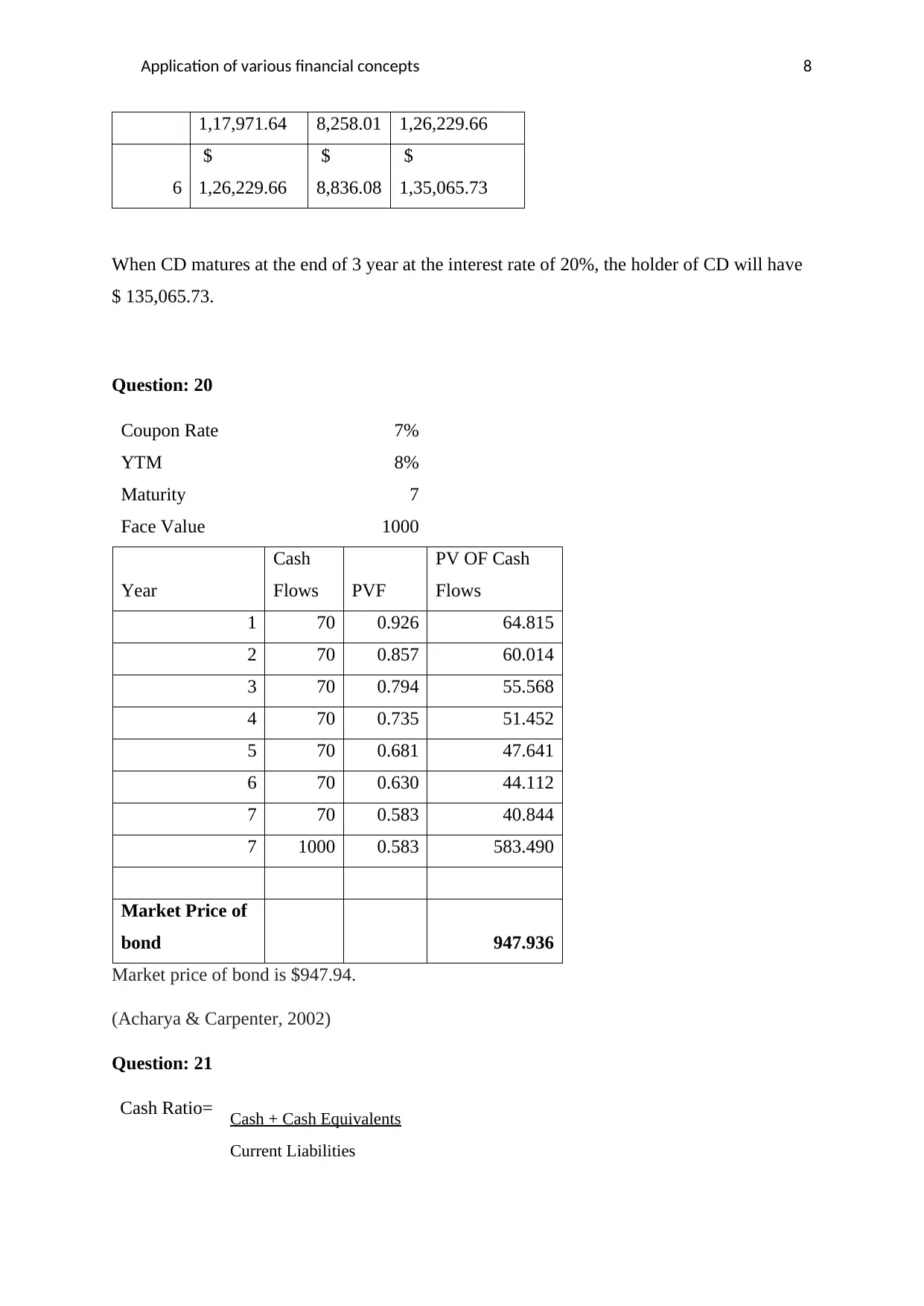
Application of various financial concepts 8
1,17,971.64 8,258.01 1,26,229.66
6
$
1,26,229.66
$
8,836.08
$
1,35,065.73
When CD matures at the end of 3 year at the interest rate of 20%, the holder of CD will have
$ 135,065.73.
Question: 20
Coupon Rate 7%
YTM 8%
Maturity 7
Face Value 1000
Year
Cash
Flows PVF
PV OF Cash
Flows
1 70 0.926 64.815
2 70 0.857 60.014
3 70 0.794 55.568
4 70 0.735 51.452
5 70 0.681 47.641
6 70 0.630 44.112
7 70 0.583 40.844
7 1000 0.583 583.490
Market Price of
bond 947.936
Market price of bond is $947.94.
(Acharya & Carpenter, 2002)
Question: 21
Cash Ratio= Cash + Cash Equivalents
Current Liabilities
1,17,971.64 8,258.01 1,26,229.66
6
$
1,26,229.66
$
8,836.08
$
1,35,065.73
When CD matures at the end of 3 year at the interest rate of 20%, the holder of CD will have
$ 135,065.73.
Question: 20
Coupon Rate 7%
YTM 8%
Maturity 7
Face Value 1000
Year
Cash
Flows PVF
PV OF Cash
Flows
1 70 0.926 64.815
2 70 0.857 60.014
3 70 0.794 55.568
4 70 0.735 51.452
5 70 0.681 47.641
6 70 0.630 44.112
7 70 0.583 40.844
7 1000 0.583 583.490
Market Price of
bond 947.936
Market price of bond is $947.94.
(Acharya & Carpenter, 2002)
Question: 21
Cash Ratio= Cash + Cash Equivalents
Current Liabilities
⊘ This is a preview!⊘
Do you want full access?
Subscribe today to unlock all pages.

Trusted by 1+ million students worldwide
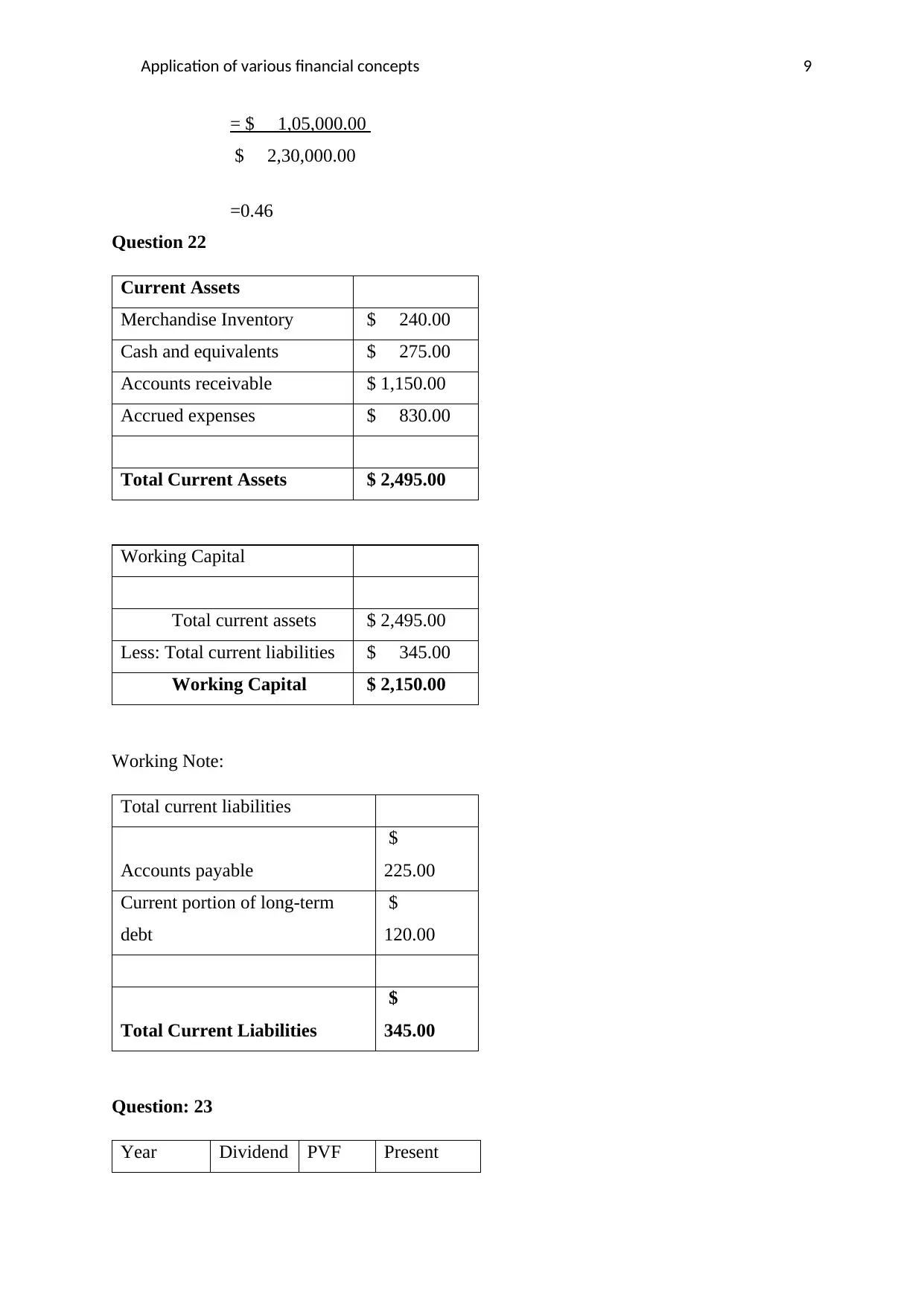
Application of various financial concepts 9
= $ 1,05,000.00
$ 2,30,000.00
=0.46
Question 22
Current Assets
Merchandise Inventory $ 240.00
Cash and equivalents $ 275.00
Accounts receivable $ 1,150.00
Accrued expenses $ 830.00
Total Current Assets $ 2,495.00
Working Capital
Total current assets $ 2,495.00
Less: Total current liabilities $ 345.00
Working Capital $ 2,150.00
Working Note:
Total current liabilities
Accounts payable
$
225.00
Current portion of long-term
debt
$
120.00
Total Current Liabilities
$
345.00
Question: 23
Year Dividend PVF Present
= $ 1,05,000.00
$ 2,30,000.00
=0.46
Question 22
Current Assets
Merchandise Inventory $ 240.00
Cash and equivalents $ 275.00
Accounts receivable $ 1,150.00
Accrued expenses $ 830.00
Total Current Assets $ 2,495.00
Working Capital
Total current assets $ 2,495.00
Less: Total current liabilities $ 345.00
Working Capital $ 2,150.00
Working Note:
Total current liabilities
Accounts payable
$
225.00
Current portion of long-term
debt
$
120.00
Total Current Liabilities
$
345.00
Question: 23
Year Dividend PVF Present
Paraphrase This Document
Need a fresh take? Get an instant paraphrase of this document with our AI Paraphraser
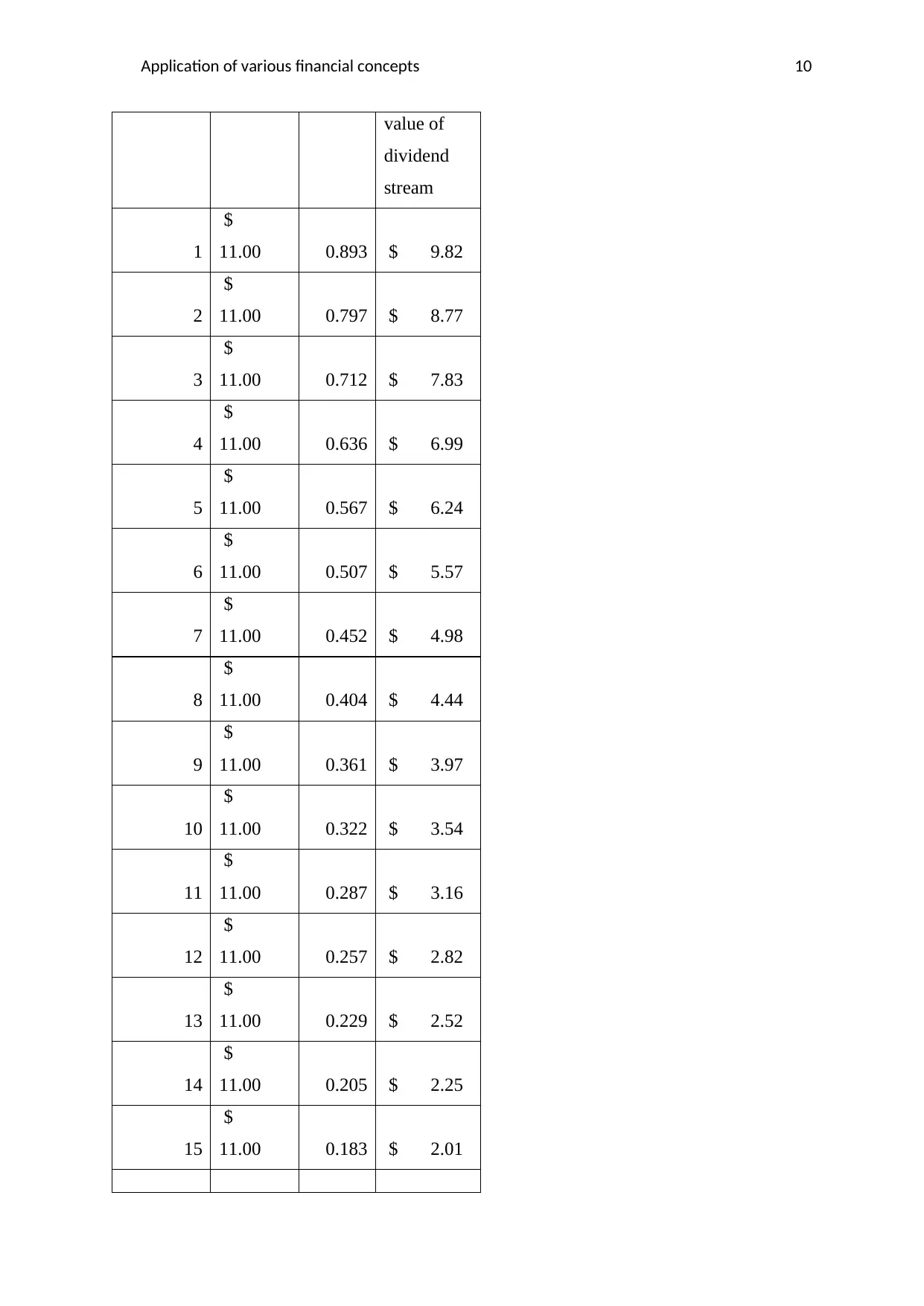
Application of various financial concepts 10
value of
dividend
stream
1
$
11.00 0.893 $ 9.82
2
$
11.00 0.797 $ 8.77
3
$
11.00 0.712 $ 7.83
4
$
11.00 0.636 $ 6.99
5
$
11.00 0.567 $ 6.24
6
$
11.00 0.507 $ 5.57
7
$
11.00 0.452 $ 4.98
8
$
11.00 0.404 $ 4.44
9
$
11.00 0.361 $ 3.97
10
$
11.00 0.322 $ 3.54
11
$
11.00 0.287 $ 3.16
12
$
11.00 0.257 $ 2.82
13
$
11.00 0.229 $ 2.52
14
$
11.00 0.205 $ 2.25
15
$
11.00 0.183 $ 2.01
value of
dividend
stream
1
$
11.00 0.893 $ 9.82
2
$
11.00 0.797 $ 8.77
3
$
11.00 0.712 $ 7.83
4
$
11.00 0.636 $ 6.99
5
$
11.00 0.567 $ 6.24
6
$
11.00 0.507 $ 5.57
7
$
11.00 0.452 $ 4.98
8
$
11.00 0.404 $ 4.44
9
$
11.00 0.361 $ 3.97
10
$
11.00 0.322 $ 3.54
11
$
11.00 0.287 $ 3.16
12
$
11.00 0.257 $ 2.82
13
$
11.00 0.229 $ 2.52
14
$
11.00 0.205 $ 2.25
15
$
11.00 0.183 $ 2.01
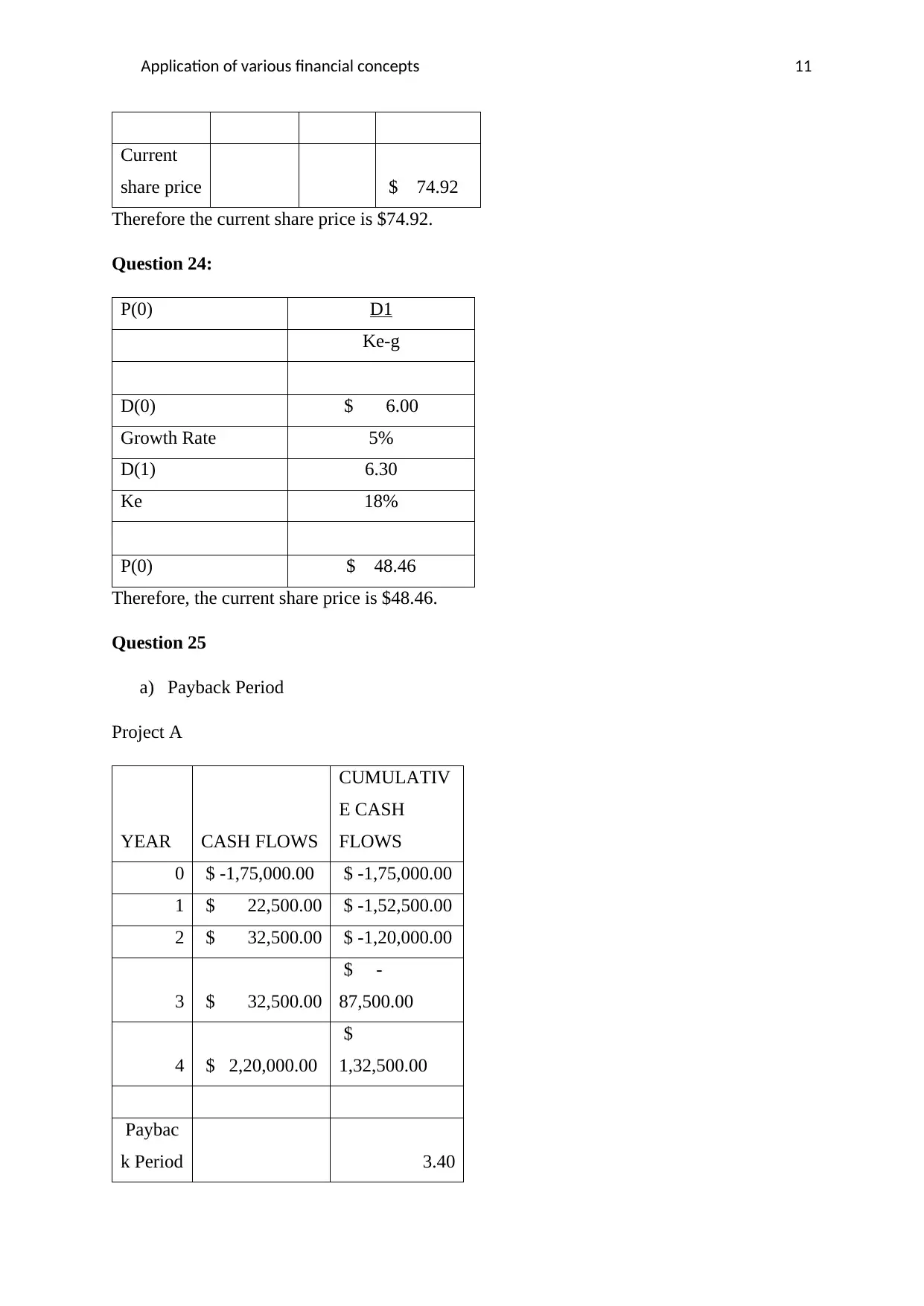
Application of various financial concepts 11
Current
share price $ 74.92
Therefore the current share price is $74.92.
Question 24:
P(0) D1
Ke-g
D(0) $ 6.00
Growth Rate 5%
D(1) 6.30
Ke 18%
P(0) $ 48.46
Therefore, the current share price is $48.46.
Question 25
a) Payback Period
Project A
YEAR CASH FLOWS
CUMULATIV
E CASH
FLOWS
0 $ -1,75,000.00 $ -1,75,000.00
1 $ 22,500.00 $ -1,52,500.00
2 $ 32,500.00 $ -1,20,000.00
3 $ 32,500.00
$ -
87,500.00
4 $ 2,20,000.00
$
1,32,500.00
Paybac
k Period 3.40
Current
share price $ 74.92
Therefore the current share price is $74.92.
Question 24:
P(0) D1
Ke-g
D(0) $ 6.00
Growth Rate 5%
D(1) 6.30
Ke 18%
P(0) $ 48.46
Therefore, the current share price is $48.46.
Question 25
a) Payback Period
Project A
YEAR CASH FLOWS
CUMULATIV
E CASH
FLOWS
0 $ -1,75,000.00 $ -1,75,000.00
1 $ 22,500.00 $ -1,52,500.00
2 $ 32,500.00 $ -1,20,000.00
3 $ 32,500.00
$ -
87,500.00
4 $ 2,20,000.00
$
1,32,500.00
Paybac
k Period 3.40
⊘ This is a preview!⊘
Do you want full access?
Subscribe today to unlock all pages.

Trusted by 1+ million students worldwide
1 out of 16
Related Documents
Your All-in-One AI-Powered Toolkit for Academic Success.
+13062052269
info@desklib.com
Available 24*7 on WhatsApp / Email
![[object Object]](/_next/static/media/star-bottom.7253800d.svg)
Unlock your academic potential
Copyright © 2020–2025 A2Z Services. All Rights Reserved. Developed and managed by ZUCOL.




